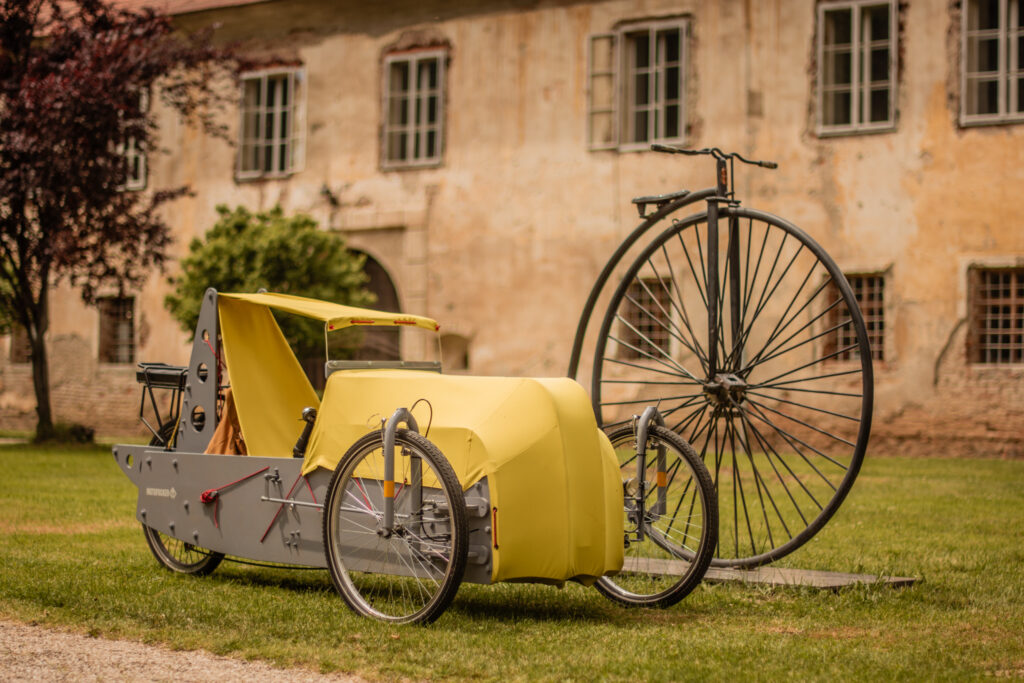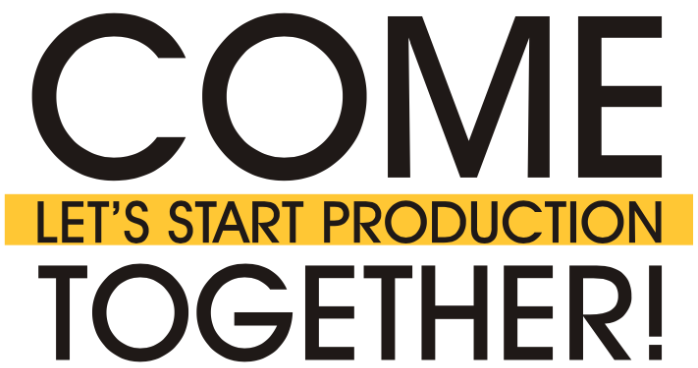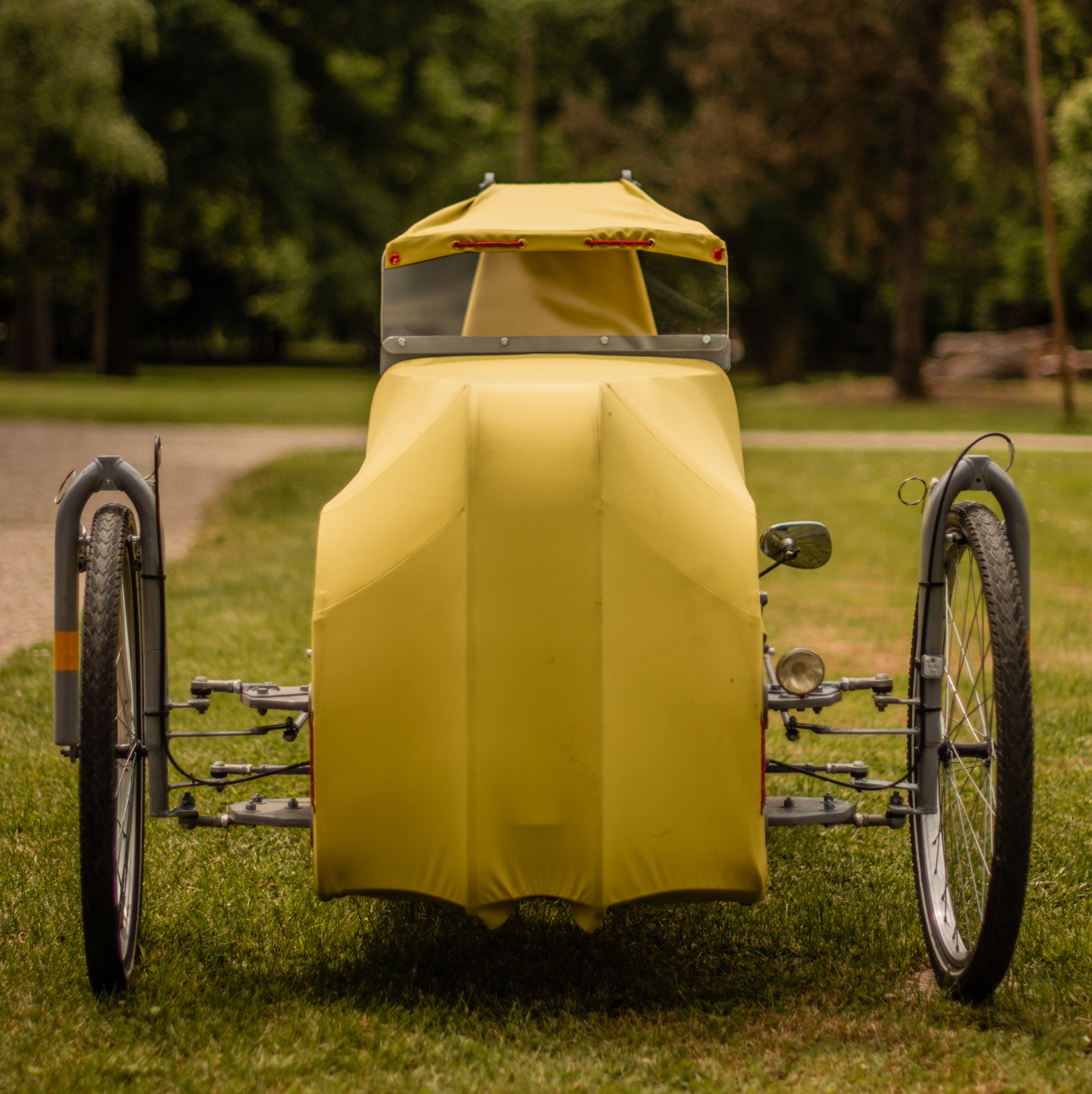What is the concept of the MOTOFOCKER VELOCAR?

Why this shape?
The shape is inseparable from the function and the material. When designing the form, the main considerations were passenger comfort (an almost reclined position), safety (an energy-absorbing zone), weather protection, ventilation, and reducing air resistance. The simple materials and technologies used required a straightforward shape.
Why these materials?
I wanted to create a vehicle that is both inexpensive and truly environmentally friendly, so I ruled out expensive and environmentally harmful composite materials as well as various light-metal alloys during the design process. These materials are not only costly and polluting, but only partially recyclable, and their manufacturing technology is complex, tool-intensive, and therefore expensive.
That’s why I chose plywood, canvas, and steel.
Why three wheels?
Three wheels are a reasonable compromise between the simplicity (and instability) of two wheels and the stability (but more complex drivetrain) of four wheels.
The only drawback is that it follows three tracks, requiring extra attention on pothole-ridden roads.
Why bicycle parts?
Bicycle components are inexpensive, standardized, and readily available everywhere.
Why steel?
Steel is a fully recyclable material—currently, 5 meters of every 6 meters of steel come from recycled sources.
We use industrial semi-finished products that are available anywhere, and the technologies involved require no production line; everything can be manufactured in a home workshop with hand tools.
Why wood?
Wood is a renewable resource with excellent mechanical properties and is recyclable. All the vehicle’s plywood parts are flat surfaces, making them easy to cut without bending molds.
Why a brush (instead of a spray gun)?
For these shapes and parts, spray painting would be unnecessary waste and environmentally harmful. There are simpler, more eco-friendly solutions, so we use those.
Why not new and special components?
Of course, it’s possible to build entirely from new parts, and in some cases that’s even recommended, but it’s not strictly necessary: standard, good-quality older parts are often higher in quality than new ones.
A key design principle was that no special components should need to be manufactured for the vehicle—only existing industrial semi-finished products adapted if needed. This choice also serves environmental, economic, and logistical purposes.
What is this velocar? How is it different from a velomobile?
I chose the name “velocar” instead of the much more familiar “velomobile” because the term velomobile has become strongly associated with the products of manufacturers using that name.
Today, velomobile essentially means ultralight, compact, extremely expensive, lightning-fast sports machines.
The word velocar (which is far less known) is much closer to my vehicle.
The original Mochet Velocar was created in the 1920s, with various models produced until 1969. Charles Mochet is credited with developing the recumbent bicycle—the common ancestor of velomobiles, tadpole trikes, and velocars.
In the case of the Motofocker Velocar (similar to the Mochet Velocar), we use wood and canvas instead of composite plastics, and steel instead of light-metal alloys. As a result, our vehicle is not as light or as aerodynamic as a velomobile and is also wider—but this makes it more stable and more spacious.
Thanks to the chosen materials and production methods, we can sell our vehicles for half or even one-third of the competitors’ price, and we also offer electric assist. The same applies to the kits.
In my view, the biggest obstacle to the spread of micromobility is overpricing and the inherently high production costs caused by a flawed design approach that relies on numerous special or imported parts.
People don’t want to pay the price of a car for a “tricycle,” or even the cost of a motorcycle.
So, either we change our mindset and produce affordable, repairable, and adaptable vehicles, or we keep making expensive sports toys for the wealthy few.
I’ve clearly chosen the first path.

Sponsorship package
50 EUR
A/4 downloadable, home-printable blueprints and assembly instructions (pdf) with a thank you letter and one-time license.
Sponsorship package
extra
500 EUR
Downloadable and printable blueprints and assembly instructions (pdf) in M=1:1 size, with a thank you letter and one-time license. If you later purchase a kit or complete vehicle, we will credit the full amount!
Be the first to know. Subscribe now and we’ll notify you when production starts. No spam, opt-out anytime.

